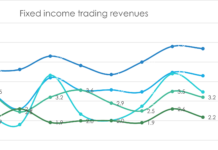High yield bonds have seen electronic trading in the US increase, with liquidity enhanced by the Federal Reserve’s announcement on 9 April that it would buy into ‘fallen angels’, meaning corporate debt that has dropped from the ‘investment grade’ credit rating to ‘high yield’ credit rating after 22 March 2020. This was unprecedented, but largely welcomed by traders.
“It has significantly improved liquidity, in both primary and secondary markets,” noted one trader. “[It] has really opened up the market and helped reverse fund flows from negative to positive.”

Thomas Hanson, head of high yield at Kames Capital, says, “Defensive, higher quality BBs have been the main beneficiaries of the turn in risk sentiment, as they are effectively viewed as the survivors come what may, and are competitively sought after often making them very hard to find, whilst lower rated cyclical industrials are the laggards, as many investors still want to cleanse their portfolios of these types of credit, despite the more depressed level of valuation.’
According to the latest guidance, the Federal Reserve’s Secondary Market Corporate Credit Facilities (SMCCF) may purchase corporate bonds in the secondary market issued by investment-grade US companies; corporate bonds issued by companies that were investment-grade rated as of 22 March 2020, and that remain rated at least BB-/Ba3 at the time of purchase; US-listed ETFs whose investment objective is to provide broad exposure to the market for US investment-grade corporate bonds; and US-listed ETFs whose primary investment objective is exposure to US high-yield corporate bonds.
Hanson adds that the action announced by the US Federal Reserve does have the ability to meaningfully change sentiment amongst investors.
“The Fed have addressed one of the main potential challenges to the market in terms of being willing and able to buy fallen angels,” he says. “They have also effectively pledged support for HY by offering to buy a small amount of HY ETFs and provide liquidity to smaller issuers under the Main Street lending facilities. This could meaningfully help out those issuers facing a liquidity crunch.”
According to the Trade Reporting and Compliance Engine (TRACE), which publishes US bond trade data, electronic trading of high yield bonds was up by 19% to reach 16% of total traded volume, while e-trading of investment grade bonds was down 11% at 27.3% of total traded volume, as reported by analyst firm Greenwich Associates. It found that average daily volume in March had increased by 31% against March 2019.
A recent analyst note by Michael Cyprys, analyst at Morgan Stanley, there were inflows to US domiciled fixed income funds of US$6.7 billion, the first week of inflows in over five weeks. Domestic bond funds inflected to inflows of US$4.6 billion, entirely driven by exchange-traded fund (ETFs) inflows and partially offset by modest outflows of US$300 million from mutual funds (MFs).
Cyprys’ noted that high yield MFs and ETFs saw its strongest week of inflows with US$7.6 billion in, the largest since tracked back to 2007, driven by both approximately US$4 billion into MFs and US$4 billion into ETFs.
©Markets Media Europe 2025













